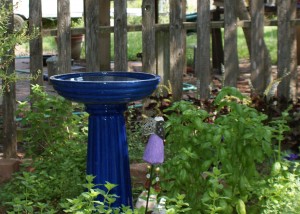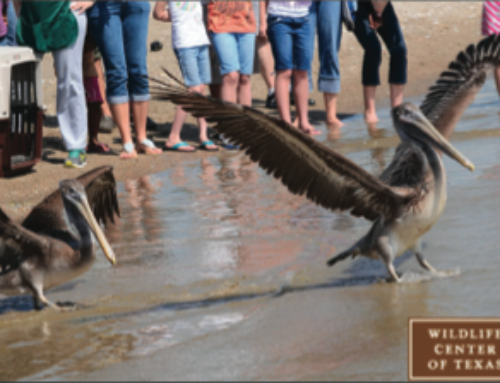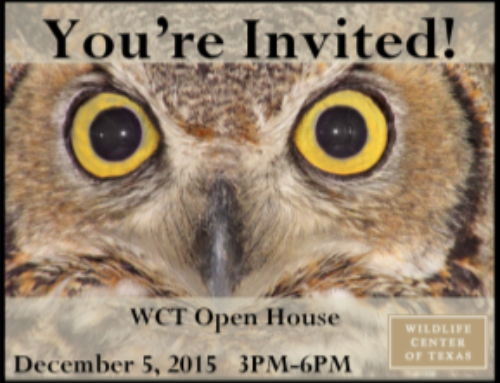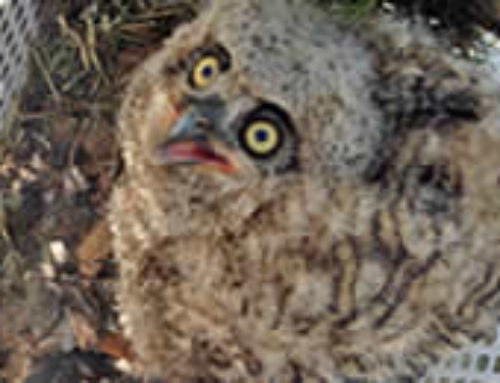The drought Texas is experiencing is one of the worst this state has ever seen. At the Wildlife Center, both mammals and birds are being brought in by the public in dehydrated and emaciated condition. There’s not much we can do to increase our chances of rain, but there are things we can do to help wildlife in their quest for survival during this extreme hot climate change. This article will look at what can be done to help different groups of animals.
Birds
Both baby and adult birds are greatly affected by the heat. The birds are either starving because their parents are struggling to find food, or the adults collapse from the traumatic heat stress they are enduring. The best way to help our native birds is to provide a water source for them to help endure these dire conditions.
 Generally speaking, a bird bath should be no more than 3” deep for birds. Change the water daily to avoid spreading disease. Do not chemicals to clean your birdbath. Just use a brush to scrub out any algae every few days. Weekly, you should rinse you freshly cleaned bird bath with a 10% solution of bleach and water. That’s just over 1 ½ ounces of bleach per gallon of water. Let the solution stand for a couple of minutes and rinse. This will kill parasites and bacteria.
Generally speaking, a bird bath should be no more than 3” deep for birds. Change the water daily to avoid spreading disease. Do not chemicals to clean your birdbath. Just use a brush to scrub out any algae every few days. Weekly, you should rinse you freshly cleaned bird bath with a 10% solution of bleach and water. That’s just over 1 ½ ounces of bleach per gallon of water. Let the solution stand for a couple of minutes and rinse. This will kill parasites and bacteria.
Place the birdbath near some small bushes or low cover. This makes them feel more secure and not out in the open and vulnerable to predators. It also allows them to have a place to fly to in order to preen their feathers after bathing.
If possible, textured birdbaths such as concrete are preferred so birds can get a better footing when bathing. Place rocks or broken pieces of terracotta pots in the middle to provide a landing area for birds. If you only have a smooth surface bird bath, you can place pebbles in it for more texture. To attract birds to the birdbath, drippers can be purchased from wild bird suppliers to create a running water sound. Most of these drippers can also be turned into misters which the birds will most happily fly through.
 You may also place small pans or plant saucers a little lower to the ground, but slightly elevated to avoid predators. Relatively speaking, the closer to the ground your water source is the more open area there should be around the water source. Experiment with different size, depth and elevation off the ground, you will find that certain species prefer different configurations.
You may also place small pans or plant saucers a little lower to the ground, but slightly elevated to avoid predators. Relatively speaking, the closer to the ground your water source is the more open area there should be around the water source. Experiment with different size, depth and elevation off the ground, you will find that certain species prefer different configurations.
Making sure plenty of food is available not only to our year round native birds, but to those that come to Houston for the summer to raise their young would be an added plus. Put out various types of seeds like sunflower, thistle, millet and cut up fresh fruit to attract a large variety of birds. To attract woodpeckers of all kinds, provide suet feeders, peanut butter spread on pine cones and mealworms. An ideal backyard could also offer a buffet of bloodworms, crickets, and suet feeders most of which can be found at your local pet store or specialized bird supply stores.
 If squirrels are the bane of your birdfeeder, purchase the metal feeder that has a pressure sensitive perch. Not only will this keep the squirrels out, it will prevent the larger birds from bullying the smaller birds at the feeder. I have 2 of these feeders, one is set high enough the woodpeckers can come for the shelled peanuts and the other is set for smaller birds so the crows and grackles can’t monopolize the feeder. Place the feeder near bushes or trees, but not close enough that the squirrels can jump to them. To slow down climbing, use a metal shepherd’s crook. Grease with vegetable shortening or purchase a baffle if the gray squirrels become to adept at climbing.
If squirrels are the bane of your birdfeeder, purchase the metal feeder that has a pressure sensitive perch. Not only will this keep the squirrels out, it will prevent the larger birds from bullying the smaller birds at the feeder. I have 2 of these feeders, one is set high enough the woodpeckers can come for the shelled peanuts and the other is set for smaller birds so the crows and grackles can’t monopolize the feeder. Place the feeder near bushes or trees, but not close enough that the squirrels can jump to them. To slow down climbing, use a metal shepherd’s crook. Grease with vegetable shortening or purchase a baffle if the gray squirrels become to adept at climbing.
Most people are unaware of mice and rats raiding the birdfeeders at night. While the population of rodents is necessary to feed the owls and hawks, no one wants an overabundance. Either use the metal birdfeeders with the spring loaded perch or bring the feeders in at night.
Many of our native birds eat insects and while providing a buffet of bloodworms, mealworms or crickets can be very expensive, you can help these birds by simply not using insecticides in your yard. I’m not suggesting that you not treat ant mounds or allow every ornamental plant be ravaged by insects – just remain mindful that even if you have plant damage in the short run, the insect eating birds will minimize this problem in the long run. One of the most damaging insects to hibiscus and other ornamental plants is the aphid. The aphid can be naturally controlled by the release of ladybugs.
Don’t forget to put out hummingbird feeders as well. Most hummingbirds migrate through in the fall and spring, but some do stay in the greater Houston all summer. When making hummingbird food, boil one cup of sugar to 3 cups of water. Make sure to change out their feeders every two to three days to avoid mildew buildup. Placing saucers of fruit in your backyard will draw flies, gnats, wasps and other smaller insects to the area. Hummingbirds are known for swooping down and snatching insects out of the air, a great protein source for them. Contrary to popular belief, hummingbirds do not exclusively drink nectar for a food source.
Squirrels
Although some people tend to find squirrels bothersome at the bird feeder, this would be an ideal time to let them share the birds’ food. They too are struggling to find food and are coming in to the wildlife center under extreme conditions. 
One suggestion to keep them out of the bird’s feeder is to provide them one of their own. This worked well in my yard until the White Winged Dove learned how fun it was to empty it. Dove are usually ground feeders, so I guess these larger dove thought the human was stupid for putting the seed in the feeder and proceeded to rectify the situation. They can empty a 3-tube feeder in less than 2 hours! In the end, dove and squirrel eat peacefully around the base of the feeder, so I guess all is well.
Squirrels enjoy fresh fruit and vegetables as well as the seed that is put out for birds. Instead of tossing wilted grapes, carrots, squash and zucchini, place bowls of these on the ground for their dinner. Shelled or unshelled pecans, acorns, and corn on the cob are some of their absolute favorites. Anything left over come evening will be eaten by the opossum or raccoon.
Squirrels need water sources also, but their preferred configuration is different than that of birds. Squirrels will come to my birdbath because there is a nearby four foot picket fence nearby to jump to and from. The one they prefer is a shallow pan that I’ve placed at the base of a tree. Squirrels don’t spend much time on the ground at my house since I have dogs, instead they have a well traveled path through the trees to the feeder. I have placed the water dish at the base of one of the trees near the feeder.
Raccoon, Opossum and Armadillo
At the Wildlife Center we do not encourage the feeding of raccoon and opossum. We understand why people want to feed these animals, but in the long run it can be more harmful than helpful. First of all, you are putting these beneficial animals out of work. Their job is to scavenge everything edible so the environment stays clean. Next you are luring animals to a single spot where contact allows disease to spread. This isn’t as important to opossums since they are immune to almost everything that preys on warm blooded animals (including venomous snakes), but distemper can jump from raccoon to raccoon like wildfire and kill all the animals in a given population. The external signs of distemper resemble rabies, so suffice it to say that it isn’t a kind death.
Another point is that you cannot control who comes to the party. In addition to the opossum and raccoon, you will undoubtedly be feeding the mice and rats too. Bird feeders and the seed left on the ground at night are magnets for mice and rats. Feeding supports a higher density of animals than the land could support itself. This increased density (especially rodents and raccoon) can wreak havoc with neighbors that don’t share your love of wildlife.
During such stressful times as this drought, the arguments against feeding become thinner, but we want you to know the consequences. Except for the argument about spreading disease, water would be very beneficial to these animals. To minimize the issue of disease, please empty and thoroughly rinse containers each day. Once a week, rinse with a solution of 10% bleach to water. A useful container for these animals is a dish that goes under a flower pot.
Butterflies and other Insects
As the hierarchy goes in nature, insects are typically at the bottom of the food chain. With no rain in sight, our vegetation, which is what a lot of insects depend on for food, is not growing. No insects, no food for the birds. The big exception is butterflies. Keep watered those plants that bloom and become a nectar source for the butterflies and bees. Milkweed and passionflower, for example, are both a nectar source and host plant for Monarch butterflies and Gulf Fritillaries. These caterpillars are then a food source for many species of birds, possums and raccoons. As the caterpillars turn into adults, a wide variety of birds become dependent on them for extra nutrition. In the meantime, it’s fun to watch the ravenous caterpillars lay waste to the milkweed and enjoy the beauty of the adults as they feed on the flowers.
Avoid using any pesticides during this severe drought unless absolutely necessary. The more insects out there for animals to eat, the better it is for all the animals. Remember, there is no pesticide that only kills one specific type of insect. When you spray a pesticide, it will kill all the insects in the area…even the beneficial ones. Also, if you have one of those electronic bug zappers in the backyard, now would be a good time to put it inside the garage to increase the population of insects as a food source for the animals who need it.
Butterflies have special requirements for drinking. They take in liquids through their proboscis, a long, hollow tube that is sort of a modified tongue. Butterflies are often seen “puddling,” or gathering at damp, sunny spots, where they get their moisture from sand or mud. Butterflies are incapable of drinking freestanding water that bird baths provide.
Constructing a butterfly watering station is easy once the requirements are known. First, you will need clean sand (sandbox sand is available at any home improvement store) and a shallow dish or birdbath. Fill the container with sand and keep it moist, mound the sand to the center or around the edges so there is always sand that isn’t covered in water. To make landing pads for them, place rocks in the middle and at the sides. Rinse the sand regularly to keep it clean and to inhibit mosquitoes from breeding there.
Besides providing watering stations you can also provide nutrition for them as well. Butterflies enjoy overripe fruit such as bananas, watermelon or pears. Place these offerings in brightly colored dishes in your backyard, to attract a variety of butterflies.
Written in conjunction with Marian Henderson






Great article – thanks for the info. A couple of months ago, we had a couple of young armadillos visit our garden. I realized I had had not drained the hose after turning it off and there was a soft, damp patch underneath where it was hanging. One of the armadillos was digging and making a little mud puddle for himself there while the other was burrowing around the garden border! They were very entertaining, but I’m sure my garden border is glad they didn’t linger too long.
Thank you for the wonderful suggestions. In June I decided to create a bird garden around my bird bath. I planted native fruit bearing plants that the native birds would eat and also put out bird feeders for many different types of birds. I was very concerned about them when I had seen a blue jay drink out of my glass of water that I left on my patio table, this action caused me to think about the wildlife suffering from the drought. At night we have seen several owls land at the bird bath and drink before flying off to hunt! We have made small changes for the birds benefit and we have so many different birds that we have now joined a backyard bird watching forum! All this from a thirsty blue jay!